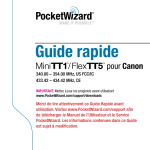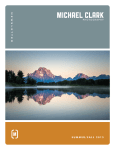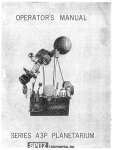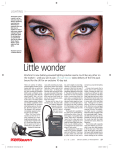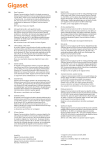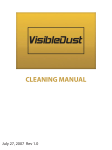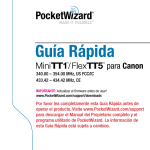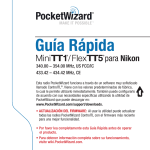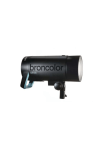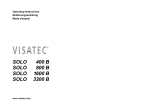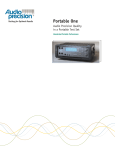Download T-One`s QT-600 Studio Strobe TesT & Review
Transcript
T-One’s QT-600 Studio Strobe Test & Review by Alessio Beltrame – www.alessiobeltrame.com The QT-600 is the midrange product of the QT series of studio strobes, distributed by T-One. The QT-600 strobe is actually a re-branded Godox QT-600, which is also distributed by which can be obtained in either of the following ways: )) Lencarta as the 600 SF (or Superfast). In this review I will also spend some words about the LP-450X portable power inverter, which is also distributed by T-One and made by Godox. A very good review on the Lencarta 600 SF (a.k.a. Godox/T-One QT-600) has been published by Phil Harbord and I’ll frequently refer to Phil’s work. I tested these strobes using a with available (continuous) light, using a fast shutter speed (like 1/1000” or quicker); )) with flashes, using equipment with a very fast flash duration. (I’m deliberately ignoring High Speed Sync and HyperSync technology in this introduction). Until now I mostly worked with available light or, to a different approach and a different experimental setup, so it limited extent, with speedlights. When compared to studio may be very interesting to compare the two reviews. You can strobes and power packs, speedlights do not require a power read Phil’s review here. plug, are easier to carry around and, to some extent, easier I will start with an introduction that explains why a fast to use thanks to TTL technology (which can be very useful flash duration, a short recycling time and the availability of a when the subject is not standing still; for example, think burst (or stroboscopic) mode are critical to me. In this intro- about a soccer player in a header action). Speedlights, as they duction I also explain why products such as the QT-600 (in all name suggests, are also blazing fast: when used at fractional its incarnations) and the Paul C. Buff’s Einstein are outstand- power (such as ¼ or 1/8) flash duration can be as low as 1/10,000”, ing exceptions in the market of studio strobes. which is roughly equivalent to a shutter speed of 1/8,000”. All readers that are eager to read my impressions and my Nonetheless, speedlight power is faint when compared measurements may jump to the following sections. Please to studio equipment. Use them on location at noon and note that in this review I use quite interchangeably the terms you find yourself fighting with the sun with no chance to strobe, monoblock and flash. Unless otherwise noted, I win. When shooting portraits on a soccer field I was forced mean an integrated, mains powered studio strobe including to shoot at sunset to be able to overpower the sun with my a generator and a head into a single case. speedlights and in many cases I had to use 2 or 3 of them at once, especially when I wanted to add a light modifier such Introduction as a softbox. As an amateur photographer, my preferred genre is sports Shooting only at sunset is a major limitation, mainly be- photography and I mainly shoot soccer. Freezing action is cause ambient light drops down quickly. You need to balance a key requirement in my work, even when I’m not shooting continuously flash light and available light and in less than sports. My portraiture subjects are athletes more often than half an hour the scene may change completely from day to not. Even my still life pictures are not so “still”, as they fre- darkness. You need to shoot fast and to think fast, so it is easy quently involve splashing water or other liquids. to make big mistakes. In order to freeze action you need a very fast exposure, 1 For these reasons I decided to purchase a set of studio T1’s QT-600 review strobes together with a portable power pack for location a portrait of a soccer player making a bicycle kick: if your work. This was the easy part, while the hardest one was to flash can keep up with your camera burst speed, then you find budget-valued strobes with a flash duration that is fast don’t need precise timing when hitting the shutter button. enough to freeze athletes moves and, for my still life shoots, Also, you could play with long time exposures and fire a se- splashing water. quence of flashes, thus obtaining the equivalent of a multiple Surprisingly or not, such products are exceedingly rare exposure. But if your flash recycles in 1.5-3 seconds, as most on the market. The vast majority of studio strobes have a strobes and speedlights do, these wonderful possibilities are T.11 flash duration as slow as 1/300”, but even the fastest one precluded to you. among the mainstream products (the Gemini Pro 500) tops All the above issues were overcome by the Einstein E640 out at 1/900” (recently Elinchrom introduced the ELC Pro HD by Paul C. Buff (PCB), a fantastic device that revolutionized line with a flash duration as low as 1/5000”, even tough this the market by introducing the IGBT technology (which is the may actually be a T.5 time instead of a T.1 time). High-end key factor in speedlights’ flash duration performance) into generators, such as the Broncolor Scoro series, have incredibly fast flash durations, but their price is scary. studio strobes. The Einsteins provide two working modes: an “action mode” for fastest flash duration (at the expense of col- Another issue of most studio strobes is that the flash dura- or accuracy), and a color mode that keeps color temperature tion is shorter at maximum power, to decrease progressively constant by sacrificing the flash duration. In action mode the as the output power is decreased. As a consequence, in order flash duration can be as low as 1/13,000” (T.1), while in color to maximize the freezing capability of these units the pho- mode it still reaches a more than respectable 1/8,000”. The tographer is forced to work at maximum power and small ap- power adjustment functions are also superb, with an 8-stop ertures. Most studio strobes are also limited in power adjust- range from 1/1 to 1/256 at steps of 1/10 stop. ment, typically within 4 or 5 stops . While this may seem to The good news is that the price of the Einsteins is cheap: be an insignificant detail, it actually may be a critical issue for approximately 500 US$ only, much less than competing 2 most amateurs and professionals that shoot both outdoors products from Elinchrom, Bowens and other mainstream and in studio. On location you need power: 400-500 Ws is the flash manufacturers. The bad (really bad!) news is that all PCB very minimum to fight the sun, 1000-1200 Ws would be defi- equipment is no longer available outside the USA. Until De- nitely better. However, a 500 Ws strobe with a 4-stop range cember 2013 PCB equipment was distributed in Europe and has a minimum power of 31.25 Ws: at that power level you Australia by PCB Europe and PCB Australia respectively (ac- can forget about using wide-open apertures such as f/2.8 or tually 1st Line Digital Pty Ltd), two front-ends for a company even f/5.6, even at ISO 100 and with an inefficient light modi- run by Colin and Julie Smith who took care of supporting PCB fier such as a soft box with a dual baffle. If you’re shooting in customers before and after sales. Starting with 2014, Paul C a small studio you don’t even have the option to recede your Buff decided to revoke the partnership with PCB Europe/ lights from the subject, due to the space constraints (and Australia and to sell their equipment through direct mar- possibly to the required size of the modifiers to maintain the ket only. For all practical purposes, PCB is no longer going same apparent dimension in relationship with the subject – if to sell equipment outside the USA (adventurous customers you want to preserve the same quality of light). may still purchase on-line, arrange delivery by themselves Recycle time is also critical to me. When shooting a soc- through a forwarding service, take care of custom duties and cer game you rely on burst mode and the higher the frame clearance, sand back and forth to the USA their equipment rate the better. But the same applies when you’re shooting at their expenses for warranty service, just to list a few incon- 1 When measuring flash duration, T.5 indicates the time it takes for the flash light to drop to 50% of peak value, while T.1 is the time for a 90% drop. For regular capacitor-discharge strobes (non-IGBT) T.1 is approximately three times longer than T.5. While T.1 is a good indication of the flash’s action freezing capability (i.e. it has a meaning for photographers), T.5 is mainly useful for marketing departments. 2 Most vendors use a clever marketing strategy to count stops. For instance, if the power ranges from 1/1 to 1/16 they count 5 stops: 1, 1/2, 1/4, 1/8 and 1/16, but those are actually 5 “power positions”. In photographic terms, this is a 4-stop range, because you’re dropping power by a factor of 24. Again, a handbook example of marketing strategy. 2 veniences). In the meantime, PCB Europe/Australia went through a face lift and became T-One (www.t-one.co) with a new mission: selling products that could replace the Einsteins from a performance and price point of view. These products are manufactured by Godox and re-branded by T-One, that also provides a 2-year warranty, a 60-day money-back guaranty and takes care of after sales assistance. I purchased from T-One the QT-600 studio strobe (3 units) and the LP-450X T1’s QT-600 review power pack, which are the subject of this review. provides a good grip. The handle is hardly slippery, but a rubber insert would have been beneficial, even though this The unboxing can not be considered a major issue. The light sensor for the The box containing the QT-600 includes everything you slave function is also mounted on the top, just near the han- need to start and more. Besides the strobe with its flash tube dle, which is generally considered to be a good design choice. pre-installed, the box contains: )) )) )) )) )) )) )) )) The enclosure is metallic, apparently an aluminum alloy, a 5 meter power cord (T-One will take care to in- a material with great heat dissipation features. The general clude a suitable plug depending on your Country); construction feels sturdy and made for a long lifetime, even a 5 meter PC sync cord; in harsh conditions. The finishing can be improved, but this a flash tube protection cap for transport and stor- is not a big issue for a studio tool. The bracket for the light age; stand is also made of metal. a 150 W modeling lamp; The weight is 3 Kg, 1 Kg more than the Einstein which is a pyrex glass protection (transparent) that is mount- also considerably smaller than the QT-600, making it more ed in front of the flash tube; portable. However, the Einstein’s body is mainly plastic, so a 7” standard reflector; the QT-600 is more resistant to frequent traveling. a couple of spare fuses; the user manual in English and Chinese. The glass cap in front of the flash tube does not add anything from the optical point of view (by contrast, the frosted Nothing to complain here. By comparison, the Einsteins and dome of the Einstein is designed to diffuse the light of the many other strobes do not include any reflector, like most modeling lamp), but it provides an extra degree of protec- high-end products. tion in case of accidental crashes of the strobe. You’d rather General features and construction gether when it breaks) than spend a hundred or so dollars to The QT-600 is the 600-Ws model of the T-One Q-Series family, replace a broken flash tube. pay a few dollars for a cheap glass cap (or forget about it alto- that includes other four models, with the same features of Strangely enough, the glass cap does not protect the the QT-600 but with power ranging from 300 Ws up to 1200 modeling lamp (see for instance Figure 2 and Figure 5). I Ws. The QT-600 is the midrange product and, with its very simply don’t understand the rationale behind this. In the first useful output range of 5 ÷ 600 Ws, it is likely to be the most pictures I saw on the web the modeling lamp was smaller popular choice in its family. and entirely protected by the glass cap, which had cooling At first sight the QT-600 appears to be a regular studio holes on the side. In the units I received the modeling lamp strobe, both in shape and dimensions. The body of the unit is noticeably larger and the glass cap has a single front hole is essentially a cylinder, with the flash tube on one side and to accommodate the lamp (see attached pictures) and to al- the user interface on the other one. The lateral surface is sub- low for air exchange. It is possible that European (220 V) ver- stantially free, except for the colorful stickers with T-One logo, sions need a different lamp, but I can’t tell for sure. The same the EU flag (I assume that this is only for European custom- applies to the metallic protection cap, which does not cover ers) and a “2-year warranty” indication which can hardly go entirely the modeling lamp. unnoticed. Speaking about power supply, there are two versions: a On the bottom the unit there are a standard mounting 200-240 Vac version and a 100-110 Vac version. Take note: bracket with a fixing knob. The tilt angle can be adjusted these strobes are not multi-voltage such as the Einsteins or through the usual lever located on the right side of the brack- most Elinchrom products. How much this is important de- et. The bottom also houses ventilation holes to ensure prop- pends on you and on your willingness to carry the strobes all er cooling. The availability of a fan is a very welcome feature, around the world. As far as I’m concerned, this is not a prob- allowing for long shooting sessions with no issues related to lem at all. I was much more worried about the power plugs, overheating. The fan is quite and barely noticeable in a typ- given that in Europe we have more power plug “standards” ical environment: unless you work in a perfectly silent room, than Countries. To this hand, kudos to T-One for shipping you know it was there only when you switch off the unit, kind power cords with Schuko plug (CEE 7/4) which is actually a of a “refrigerator effect”. German design, but is very popular here in Italy too and it is When tilting or transporting the unit, the handle on top becoming the de facto standard throughout Europe. 3 T1’s QT-600 review Figure 1. The unboxing Figure 2. Top view Figure 3. Elevation view Figure 4. Back view with user interface Figure 5. Detail of flash tube and modeling lamp 4 Figure 6. The included reflector and the hole for umbrella T1’s QT-600 review Regarding light modifiers, the QT-600 is compatible with associated with a LED that lights up when the corresponding Bowens (S-type) speedrings, probably the most diffused function is active (the test LED is lit when the flash is ready standard on the market. This opens a world of possibilities, to fire). The lamp and buzzer LED’s are blue, the test LED’s is allowing you to use all Bowens modifiers as well as all no- red. The optical slave LED is bi-color: it glows blue when the brand, inexpensive imitations. Of course cheap soft boxes standard slave mode is active (the first flash detected by the or beauty dishes may not provide the light quality of high light sensor triggers the unit), it glows red when the pre-flash end modifiers such as the famous Elinchrom Deep Octa, but slave mode is active (the optical sensors ignores the first flash at least you can choose products that meet your budget. By and triggers the strobe on the second one - this mode may comparison, the Einstein adopts the Balcar standard, so you be useful when working in conjunction with TTL speedlights). basically need to use PCB modifiers or purchase speedring Buttons’ captions are orange on a dark gray background. adapters. While looking great, this is hardly the best choice in terms The standard reflector and the body of the strobe provide of readability, particularly in low light conditions. Personally an 8-mm hole for an umbrella shaft. Some users reported speaking, this is not a problem in most circumstances: How that the shaft is locked by a spring-loaded mechanism which often would you change the setting of the buzzer or the op- is rather stiff. I don’t use umbrellas, so I didn’t test this. tical slave during a shoot? What you’re likely to use the most As regards the modeling lamp, I consider its power to be is the test button, followed by the modeling lamp switch. adequate, but nothing more. Use it in studio with common These two functions are found on the rightmost and leftmost modifiers at a typical distance from the subject and it will buttons, so they are easy to locate even in complete darkness. deliver all the output you need to focus on the subject and The modeling lamp is adjusted manually through the left to get a preview of what you pictures will look like. But don’t knob in continuous mode (there are no fixed steps). Unfor- expect to use the modeling lamp of the QT-600 like a source tunately, there is no proportional mode regulation, i.e. the of constant light and to shoot people at low ISO. modeling lamp can not be adjusted automatically in proportion to the flash power. User interface Visual confirmation is available instead. This function The user interface of the QT-600 is quite minimalistic: two turns off the modeling lamp when the flash fires and turns it knobs, four buttons, a 2-digit 7-segment LED display and on again when the recycle is complete and the flash is ready a power switch, that’s all. Compared to this, the 2.4” LCD to fire again. This offers a visual clue that the strobe has been screen of the Einstein seems to be a product of a science fic- triggered. Many photographers prefer to use this function in- tion novel. But do you really need something this fancy in a stead of the buzzer, which can be annoying particular when real-life photoshoot? Hardly, in my opinion. When I shoot I there are many strobes active at the same time. In that case it prefer to keep my focus on composition, on exposure and on is also difficult to understand which flash is ready and which the engagement with the subject , if it’s human. I just don’t not. Visual confirmation is always active, so there is no way to care about the current color temperature and flash dura- turn it off. Not a big concern, as most photographers would tion, as long as I’m confident that they are within a specific keep it on at all times. range (who cares if the flash duration is 1/12250” instead of 1/11130”?). Flash power (more precisely, flash energy) is adjusted through the right knob which is not stepless. There are a to- By contrast, in my opinion a knob is a much more conve- tal of 51 levels or steps, ranging from 10.0 (maximum power) nient way to adjust power than a couple of buttons. On the down to 5.0 (minimum power) in 0.1 decrements, plus an QT-600 you can drop power by 4 stops with a quick gesture additional step that disables the flash tube (displayed as “0F” of your fingers, while on the Einstein (and all other button for “off”) . Please see the paragraph below for details about controlled strobes) you need to press the “minus” button 40 power adjustment. times (or keep it pressed for a while). The modeling lamp has There are two connectors on the back: one is a standard its own knob, so you don’t need to press a “function” button 6.35 mm jack for synchronization with a PC cord or with any before using the ± buttons to adjust light. standard wireless trigger (such as a PocketWizard). I test- The four buttons are used to control modeling lamp (on/ ed the unit with a Pixel Soldier wireless radio trigger and it off ), buzzer (off/on), optical slave function (on/off/pre-flash worked flawlessly, never missing a shot. The second connec- mode) and to trigger the flash (test function). All buttons are tor is an USB port that is specifically predisposed for the con- 5 T1’s QT-600 review nection of the Godox FT-16 wireless receiver. The correspond- flash with a light meter (Sekonik L-358) located at a distance ing Godox FT-16 wireless transmitter basically replicates all of 1 meter from the flash tube, at ISO 100. The reading of this functions available on the QT-600, thus allowing to set power, measure is actually the flash Guide Number (GN) in meters. to switch the modeling lamp and the buzzer remotely, right Of course, there are many factors that may influence the from the top of your camera. The FT-16 kit is inexpensive and measurement, including: allows to control up to 16 groups of strobes, much more than what is needed in typical situations. Anyway, I didn’t purchase this remote trigger set (yet), so I’m not including it in this review. )) )) )) )) the reflections from the environment; the light modifier used with the strobe (if any); the light meter measuring mode; etc. I also tested the optical slave in regular mode and it I performed the test in a 4x3x2.7 m room with white walls and worked flawlessly. I didn’t test the optical slave in pre-flash ceiling and a light parquet floor. The strobe was mounted on mode. a light stand at approx 1.2 m from the ground and equipped Power adjustment standing on a desk with the light dome in recessed position. with the standard 7” reflector. The Sekonik light meter was According to the user’s manual, the QT-600 allows to adjust Several systematic errors may affect the measurements. power in a range of 7 f-stops3, i.e. from 1/1 to 1/128th. This is First of all, I couldn’t calibrate the light meter using a reputa- one f-stop less than the Einstein, but still a remarkable range. ble reference. In addition, any small variation in the relative As most digitally controlled strobes, the QT-600 provides a position of the light meter and the strobe could have pro- step-by-step regulation using a scale that goes from 5.0 (low- duced a small, yet detectable deviation in the measures. For est energy) to 10.0 (highest energy). This is actually 51 steps, these reasons, please take the following data with a grain of but if each step corresponded to 0.1 f-stops then one would salt. expect 71 steps, for instance from 3.0 to 10.0. How this is explained? For each power level, starting from highest energy (10.0) I took four readings: the first two are consecutive, at most five The answer is that the energy scale is not linear: from 10.0 seconds from each other (i.e. fire, read the result, fire, read the down to 6.0 every step actually corresponds to 0.1 f-stops, result). Then I dropped the power to the next level, took two while from 6.0 down to 5.0 every step corresponds to rough- more readings and so on down to the lowest energy (5.0). ly 1/3 f-stop. I don’t know why Godox engineers chose this Next, I raised again the energy up to the max and I took the solution, which is to some extent counterintuitive (at the bot- third sequence of single readings from 10.0 to 5.0. Finally, i tom of the scale) , but it’s likely to be a cost-related decision. switched to another strobe and took the fourth sequence of Anyway, the most important fact is that the flash energy readings. In such a way I tested a short-time power consisten- is widely adjustable. When using the QT-600 outdoors you cy (two consecutive flashes), a mid-term power consistency can take full advantage of its 600 Ws power, which is rough- (comparing two flashes at the same power but at an interval ly equivalent to 8 speedlights working together. In a small of approx. five minutes) and a unit-to-unit power consistency studio you can go down as low as 5 Ws, corresponding to a (comparing two different strobes). speedlight at 1/16 power. This is what I call flexibility. The results are listed in Table 1. For each power level you can find a theoretical guide number (based on manufactur- Power measurements er data for full power), the theoretical light meter reading In order to verify if the QT-600 lives up to its claims, I per- (same as guide number but expressed in f-stop notation) formed a number of “lab tests” in my home studio (I’d rather and the actual reading from the light meter in the four mea- call them “domestic tests”). I wanted to verify: surements. Regarding the notation, I used the normalized )) )) )) the actual power level in relationship with the man- f-stop scale (4, 5.6, 8, 11, 16, 22, …) plus decimal f-stops. For ufacturer’s specifications; instance, 8 + 0.3 means f/8 plus 1/3 stop, i.e. f/9. the consistency of power output from flash to flash in my opinion power consistency is nothing short than excel- the precision of the power adjustment scale. lent. For the same strobes (reading #1, #2 and #3) the output The test consisted in measuring the luminous intensity of the 3 See note on page 2 6 Some considerations about the above results. First of all, and from unit to unit; level is consistent within 0.1 stops, which for all practical purposes means that the output is absolutely identical. This is T1’s QT-600 review Flash energy Theoretical Theoretical Reading Reading Reading Reading (display value) guide number f/stop #1 #2 #3 #4 10.0 76,0 64 + 4/10 45 + 8/10 45 + 8/10 45 + 8/10 45 + 6/10 9.5 63,9 45 + 9/10 45 + 3/10 45 + 3/10 45 + 4/10 45 + 2/10 9.0 53,7 45 + 4/10 32 + 8/10 32 + 9/10 45 + 0/10 32 + 7/10 8.5 45,2 45 + 0/10 32 + 5/10 32 + 4/10 32 + 5/10 32 + 3/10 8.0 38,0 32 + 4/10 32 + 0/10 32 + 0/10 32 + 1/10 22 + 9/10 7.5 32,0 32 + 0/10 22 + 5/10 22 + 4/10 22 + 5/10 22 + 4/10 7.0 26,9 22 + 4/10 22 + 0/10 22 + 0/10 22 + 0/10 16 + 9/10 6.5 22,6 22 + 0/10 16 + 5/10 16 + 5/10 16 + 5/10 16 + 3/10 6.0 19,0 16 + 4/10 16 + 0/10 16 + 0/10 16 + 0/10 11 + 8/10 5.7 13,4 11 + 4/10 11 + 6/10 11 + 6/10 11 + 6/10 11 + 4/10 5.4 9,5 8 + 4/10 8 + 7/10 8 + 8/10 8 + 7/10 8 + 6/10 5.0 6,7 5.6 + 4/10 5.6 + 0/10 4 + 8/10 5.6 + 0/10 4 + 9/10 Table 1. Measured power output at 1 meter with standard reflector and at different power settings also the precision of the measuring instrument, so a 0.1 stop output difference is within the experimental error box. “real-world” test using 1.5-meter (5-feet) octagonal softbox (or octabox), again at full power by this time I measured the out- As regards the second strobe (reading #4), the difference put at a more typical (in relation to the size of the modifier) in output is more noticeable, yet limited to an almost negli- distance of 2 meters. I also repeated the test with a 50-cm gible 0.2 to 0.3 stops. You may also notice that this series of (20-inch) beauty dish and obtained the same results of the measurements is consistently fainter than readings #1/#2/#3. octabox. Table 2 lists the readings for 3 different test con- As i switched strobes for this test, it may be that I accidental- ditions. ly changed the setup (especially the distance between the The results show that the QT-600 can easily balance the strobe and the light meter), thus introducing a systematic er- environmental light of a sunny day at noon, even with an in- ror. In any case, to me a 0.2-stop difference among different efficient light modifier such as a softbox, having the subject 2 strobes is still a great result. meters away from the modifier. One last comment about maximum power. From my mea- In summary, my feeling is that the actual guide number is surements it appears to be approximately 2/3 stops below the less than the declared 76 meters, but I doubt that the differ- nominal value. However, if you look at the various readings at ence is as large as 0.6 stops. I’d say that the real guide number different power levels you find a -2/3 value at all power levels. is somewhere between 65 and 72, but I can’t tell for sure be- Here I can feel the smell of a systematic error: it is possible cause I reached the precision limits of my home lab. Which- that part of the difference is due to my light meter, which ever the truth, this strobe has undoubtedly plenty of power has not been calibrated before the test. Perhaps there’s also even for outdoor use and is dimmable enough to be used in something wrong with my experimental setup. For sure a a small studio with large apertures such as f/4 and even f/2.8. more efficient reflector, or one with a more focused spread angle, would have produced a higher measurement. Color consistency A test performed with a standard reflector at full pow- IGBT flashes are know to be very fast, but in most cases they er and 1 meter distance may be unrealistic from a practical compromise flash duration with color temperature stabili- point of view. Therefore, I also carried out a somewhat more ty. As the output power is reduced, flash duration becomes faster but color temperature rises towards a more bluish Test condition (at full power - 10.0) Reading at 2m hue. This color drift may be easily in the 300-500 K range. In Beauty dish - white - Ø50 cm 16.0 Action Mode the Einstein works exactly in this way. However, Octagonal softbox - 150 cm - without baffles 16.0 the Einstein also features a Constant Color Mode that keeps Octagonal softbox - 150 cm - with baffles 11.8 color temperature within ±50K over the entire power range. Table 2. Measured power at 2 meters with light modifiers This is obtained by reducing the voltage applied to the 7 T1’s QT-600 review flash tube. The downside of this technique is a slower flash for instance K2 refers to the second measurement of color duration, which drops from 1/13,500” to 1/8000” (at lowest temperature. power). I’m really impressed by the results. Within a range of With the QT-600 you can’t choose between the equiva- 7 f-stops the color temperature is 5300 ± 100 K, a little bit lent of the Action Mode and the Constant Color Mode. The warmer than the specifications yet accurate to within 100 K manufacturer claims a color accuracy of 100 K (more precise- as promised. Only four measurements out of 44 fall outside ly 5600 ± 100 K), which would be a very good performance of the specification, namely the second and third one at low- at any price level and just marginally worse than Einstein’s est power, the fourth one (different strobe unit) at 8.5 and spectacular accuracy. 7.5 power levels. We may safely consider them as statistical I have no instrumentation for a direct measurement of errors. the color temperature of a flash, so I tested the color accu- The second unit under test (fourth measurement) is racy in an indirect way. Basically, I took a number of shots of slightly cooler the first one, still the color temperature differ- a white balanced gray card at different power levels, setting ence is only 100-150 K. my camera (Canon EOS 7D with EF 70-200 L IS USM II lens) to While not as good as the Einsteins, the QT-600 is definitely Auto white balance and shooting tethered into Adobe Light- much better than brand-name expensive strobes. If we take room. For each picture I noted the Temperature (Kelvin) and Paul C Buff literature at face value (it may be found here), a the Tint (Green/Magenta balance) slider values. renowned strobe like the Profoto D1 500 has a color drift of Working in Auto White Balance mode my Canon 7D an- no less than ±300 K over its power range (1/1 to 1/64). Another alyzed the scene and applied a color correction to make the top selling pro strobe, the Elinchrom RX 600, has a smaller gray card appear neutral. It made a great work: in all pictures color drift (±200 K), but its power range is also smaller (1/1 to the red, green and blue channel are accurate to within 0.1- 1/32, or one stop less). According to Phil Harbord’s test (see the review here), the 0.2%. To our purposes, this means that the color temperature and green/magenta balance reported by Lightroom are in- Lencarta 600 SF (a.k.a. T-One/Godox QT-600) is voltage com- deed a good representation of the color of the flash light. pensated to maintain color temperature constant. My mea- I used the same basic procedure I described in the Power surements are perfectly aligned with Phil’s ones and confirm Measurement section. I made four series of shots at the vari- that the QT-600 implements something very similar to the ous power levels: the first two are consecutive, the third one Einstein’s Constant Color Mode. approx. five minutes later and the fourth one comes from a different strobe. Table 3 reports the results. For the sake of completeness, I also measured color consistency in a rapid fire sequence. I first ran a series of 10 shots K stands for color temperature (in K – Kelvin degree) and G/M stands for Green/Magenta balance (±100, with 0 being at ¼ power (8.0) and approx. 4 fps (frames per second). Next, I repeated the test at 1/8 power (7.0) and 8 fps. the neutral value); the number refers to the measurement, so The results are almost incredible: all 10 shots at a given Power (display) K1 G/M1 K2 G/M2 K3 G/M3 K4 GM/4 10 5200 17 5200 12 5250 12 5350 11 9.5 5300 12 5300 12 5300 13 5350 11 9 5250 13 5250 13 5250 13 5400 12 8.5 5250 13 5250 13 5300 13 5450 12 8 5300 14 5300 13 5350 14 5400 12 7.5 5250 13 5250 13 5300 13 5500 13 7 5200 11 5200 12 5250 12 5400 12 6.5 5200 12 5250 12 5300 13 5400 12 6 5150 10 5150 10 5200 11 5350 11 5.5 5350 13 5350 13 5350 13 5300 10 5 5400 15 5450 15 5550 16 5350 11 Table 3. Color temperature and green/magenta balance at different power levels 8 T1’s QT-600 review power had the same, identical color temperature! At ¼ power you may obtain similar results (in most cases) by manually (8.0) the temperature was a little bit cooler than at 1/8 power triggering the strobe. (7.0), but we are still within the ±100 K range. Recycle time and fast fire Flash duration Last but not least, I measured the flash duration. To me, this If there is one field where the QT-600 beats the Einstein with- is the key feature for a strobe and any flash duration slower out question, it is recycle time. The manufacturer claims a re- than 1/1000” (T.1) is a game-stopper. I need a super fast flash, cycle time of 1.2 seconds at full power and I can confirm that. because freezing action is the main concern in my photog- In detail, I measured a recycle time of 1.0” at full power, but I raphy. performed this measurement by hand with a stopwatch, so The QT-600 is rated at flash durations of 1/5000” at lowest it is safe to assume a ±0.2” precision. This means that, in the power, while Lencarta for their identical 600 SF go well be- worst case, the specification is confirmed. yond and claim an incredible 1/20,000”. Which one is correct, At lower power the recycle time gets more and more quicker, reaching 0.05” at minimum power. I couldn’t mea- if any? In his review, Phil Hardbord checked the light output with sure that, as it would require some sort of automatic appara- an oscilloscope and substantially confirmed the 1/5000” fig- tus. What I tested was shooting in burst mode: I set my Canon ure, measuring an even better 1/5400” T.1 at minimum power. 7D in fast burst mode (8 frames per second) and I kept de- According to Phil, T.1 is less than 1/1000” (actually 1/1400”) pressed the shutter button (see also the paragraph on color even at 1/2 power, while at full power (where IGBT technology consistency above). At ¼ power I obtained an alternation of good and total- has no role to play) the T.1 is an unexciting, “regular” 1/500” (but this leaves an open door for HyperSync, see below). ly black pictures: the first good, the second black, the third Unfortunately, I have no means to replicate Phil’s mea- good, the fourth black and so on. The flash fired on each odd surements, because I miss the necessary instruments. Instead, picture, but it hadn’t time to recycle before the next even I used an indirect measurement technique, which consists shot in the sequence. This means that, for all practical pur- in taking a number of shots of a spinning disk (see Figure poses, at ¼ power the QT-600 has a recycle time of 0.25” or 7–this is basically the same approach used by Lencarta) less. with available light only (no flash) and with different shut- The situation is even better at 1/8 power: all pictures in ter speeds ranging from 1/250” to 1/8000”. At slower shutter the 10-shot sequence were lit correctly, meaning that at this speeds the marks on the disk appear blurred due to the fast power (for all practical purposes) the recycle time is only disk rotation, but at higher shutter speed they look more and 0.125” or less. more identical to a picture of the disk when it is standing still. I’d like to point out that an IGBT flash like the QT-600 may Then, I took another series of pictures of the spinning fire before recycling completely (if not working at full power), while regular voltage-controlled flashes can not. This is why I say “for all practical purposes”: I just don’t care if my strobe has fully recycled or not, as long as it can fire when I want it to. Perhaps at 1/8 power and 8 fps the QT-600 does not recycle completely and eventually, maybe after 50-60 flashes, it will need a short pause to recharge completely its capacitors. But then, who cares of shooting a burst of 50 pictures? 10-15 consecutive frames is all I ask and the QT-600 delivers. Unfortunately, the QT-600 has no automatic stroboscopic (multi-flash) mode to fire a sequence of flashes at regular, preset intervals. One use of this function is to emulate a multiple exposure in dark environment, by setting a slow shutter speed (like 4 seconds) and firing a burst of flashes at a moving subject. How the lack of this function may affect your photography is highly subjective, but keep in mind that Figure 7. Test target 9 T1’s QT-600 review What i found is reported in Table 4. While not as good as Lencarta figures (which, a priori, seemed to be more commercial hype than actual facts), my results substantially confirm Phil Harbord’s measurements and, consequently, manufacturer data (with a major deviation at full power – see also the paragraph about Hypersync at page 10). Regarding flash duration, the QT-600 is comparable to the Einstein in Constant Color Mode (at the same power output), while the Einstein has the edge when used in Action Mode. In most situations, including all those involving human Figure 8. Still target with continuous light subjects, the flash duration of the QT-600 is fast enough to obtain tack sharp results. This alone is enough to put the QT- disk with flash light only at different power levels. Finally, I 600 on a higher ground, where only a handful of monolights compared each flash-light picture with the available-light can stand (including the Einstein, the Elinchrom ELC PRO HD pictures to find the equivalent level of action freezing. To put and the Profoto B1). Speedlights may be even faster, but they it in another words, if a flash-light image presents the same are definitely less powerful. Generators may also be faster, amount of motion blur of an available-light image shot at but a completely different price level. 1/4000”, then we can conclude that the flash duration in the first image was approximately 1/4000”. Considering that I’m shooting mainly people and splashing liquids at moderate magnification, I don’t need the extra I know the objections: this is a qualitative test (not quanti- speed of the Einstein in Action Mode and I’m probably in tative), the evaluation of motion blur is subjective and it is dif- good company, with the 99% of photographers. The special- ficult to compare samples when in each of them the amount ists in high speed photography (e.g. bullets shattering fine of blur is small. wine bottles) are desperately in need of the shortest flash du- My counter-objection is that I really don’t care about the ration, regardless of color stability, price and other consider- cold numbers, I’m only interested in the end result. If at 1/4 ations. Those photographers may well consider the Einstein power I can get a picture which is equivalent to shooting at a better option, even though extreme action freezing may 1/4000” then I don’t care if T.1 is 1/4000” or 1/3800” or even require something even faster. 1/5000”. I want to freeze moving subjects and all I need to know is how much I have to dial down the power to get what HyperSync capabilities I want. Also, I’m publishing the test results, so you can judge Most DSLR does not allow for flash synchronization at shutter by yourself. You can see the still target with continuous light speeds faster than 1/160” to 1/320” (depending on camera). in Figure 8 and a comparison between continuous light and This is known as the X-Sync speed. Medium format cameras flash exposure in Figure 9 to Figure 24 (all flash exposures equipped with leaf shutter may have a higher x-sync speed are at 1/250” - ISO 100 - aperture from f/11 to f/32; continu- (1/800” to 1/1600”), but only digital cameras with electronic ous exposures are at f/11 and ISO 6400). shutter (typically, point and shoot cameras) have no limits in Power - display (Ws) Equivalent Shutter Speed 10.0 (600 Ws) 1/1250” 9.0 (300 Ws) 1/2000” 8.0 (150 Ws) 1/2500” 7.0 (75 Ws) 1/3200” 6.0 (37.5 Ws) 1/4000” 5.7 (19 Ws) 1/4000 5.4 (9.5 Ws) 1/5000” - 1/6400” 5.0 (5 Ws) 1/5000” - 1/6400” Table 4. Flash duration at different power levels x-sync speed. For daylight sports photography a slow x-sync speed may be a problem. I won’t go into technical details here, but to freeze a moving subject with no visible halos (due to available light coupled with a slow shutter speed) you need to underexpose the environment by at least 3 stops. You can’t balance flash and available light, otherwise part of the moving subject would appear “smeared” due to the (relatively) long exposure of the available light. HyperSync technology (not to be confused with High Speed Sync) was introduced by PocketWizard (see here) to overcome the x-speed limits (other trigger manufacturers are 10 T1’s QT-600 review Figure 9. Continuous light @ 1/8000" Figure 10.Flash @ 5.0 (1/128 power) Figure 11.Continuous light @ 1/4000" Figure 12.Flash @ 5.3 (1/64 power) Figure 13.Continuous light @ 1/3200" Figure 14.Flash @ 5.6 (1/32 power) Figure 15.Continuous light @ 1/2500" Figure 16.Flash @ 6.0 (1/16 power) 11 T1’s QT-600 review 12 Figure 17.Continuous light @ 1/2000" Figure 18.Flash @ 7.0 (1/8 power) Figure 19.Continuous light @ 1/1600" Figure 20.Flash @ 8.0 (¼ power) Figure 21.Continuous light @ 1/1250" Figure 22.Flash @ 9.0 (½ power) Figure 23.Continuous light @ 1/1000" Figure 24.Flash @ 10.0 (Full power) T1’s QT-600 review now proposing similar functions). It allows you to trigger a flash at any shutter speed, but results are a mixed bag and strongly depend on which DSLR and which flash you use. For better results you need to use a strobe with a long flash duration. With super fast flash duration like 1/5000” T.1 this technology simply does not work. Does this means that you can’t HyperSync with the QT600? Maybe. For sure, at most power settings the flash duration is too short to work with HyperSync. However, at full power the QT-600 works exactly like a conventional strobe, so this leave a door open. Figure 25.Triggered by Pixel Soldier @ 1/320 To test this possibility, I triggered the QT-600 using either a PC-sync cable or a couple or radio triggers, and I got the usual banding on the bottom of the frame starting from 1/320” (with the radio triggers – Figure 25) and 1/400” (with the sync cord –Figure 26). This happens because the flash is fired only when the first curtain is fully open, but the second curtain is already moving. To determine if the QT-600 can hypersync I used the trick to sync the strobe through a speedlight in HSS mode. I mounted my Canon 430 EX II on top of my Canon EOS 7D and set it in High Speed Sync mode to force the 7D to accept shutter speeds faster than 1/250” (which is the x-sync speed of the 7D). I set the 430 EX at min- Figure 26.Triggered by Pixel Soldier @ 1/500" imum power (1/64), so it had no role in the exposure of the scene. The QT-600 was set in Optical Slave mode at maximum power (10.0, corresponding to 1/1). In this case the flash is fired soon after the fist curtain starts moving (i.e. before it is fully open). This time I obtained a top banding, more precisely a very steep gradient (Figure 27 and Figure 28) at the middle of the frame going from white (at the bottom) to black (at the top). Considering the quick falloff, you may assume that the flash duration of the QT-600 is too short, even at full power. Perhaps, the QT-600 cuts the tail of the flash pulse also at full power, as suggest- Figure 27.Triggered by 430 EX II in HSS - 1/500" @ f/5.6 ISO100 ed by the quick flash duration (1/1000”) I found in the above mentioned tests. On the other hand, you may notice that the frame is relatively dark even on the bottom and using a relatively large aperture (f/5.6), suggesting that the sensor was exposed only to the tail of the flash pulse (i.e. the flash was triggered too late). Whatever the truth, my tests are inconclusive. Of course, the failure of hypersyncing the QT-600 using my HSS/Slave trick does not prove that the QT-600 can not be hypersynced at all. Other IGBT strobes (including the Einstein) and many speedlights are know to work with hypersync when trig- Figure 28.Triggered by 430 EX II in HSS - 1/2000" @ f/5.6 ISO100 gered by PowerWizards or other triggers that support an ad- 13 T1’s QT-600 review justable delay such as the new Phottix Odin or the Ojecoco parts are kept together by 4 levers located on the side of H550. the unit and it is very easy to replace the battery with a ful- A final judgment on this matter definitely requires an ly charged one. You can also use and external 12V battery, empirical evidence which, unfortunately, is not available yet. such as a car battery: you just need to connect it to the two plugs that are provided on the side of the unit. LP-450X Lithium Battery Inverter There is a handle on top for easy transport, but the LP- As a mains-powered unit, the QT-600 needs to be connected 450X comes with a nice carrying bag with many sockets that to a 220 Vac or a 110 Vac power outlet. When your are on can be used to store the AC charger, cables, etc. location, a battery powered inverter (also known as battery pack) allows you to use your strobes anywhere. The inverter supports two working modes: a normal working mode to feed standard appliances (e.g. notebooks, Most of my outdoor shootings involve soccer players on printers, etc.) and a flash mode which is appropriate for soccer fields: no mains outlets there, so I definitely needed strobes. In normal mode the maximum continuous power an inverter for my strobes. I ordered from T-One an LP-750 output is 450 W, while in flash mode you need to think in unit, but they actually delivered a more advanced LP-450X terms of watt-seconds. From a practical point of view, the (see more about this later). The LP-450X is based on newer LP-450X supports multiple strobes up to a total of 1800 Ws, technology, i.e. a high capacity Lithium Ion (LiFePO4) battery which is perfectly adequate to connect my three QT-600’s. with an excellent 12 Ah capacity. The normal mode is a distinguishing feature of the LP- The LP-450X is relatively compact (267 x 206 x 292 mm) 450X. For instance, the Paul C. Buff’s Vagabond Mini Lithi- and lightweight (6.8 Kg). Three multi-standard power plugs um, one of the most popular battery packs, is not intended are available on top of the unit, as well as 3 USB ports for to power continuous loads such as the modeling lamps. powering or re-charging portable devices (smartphones, Instead, the LP-450 can happily feed any standard electric GPS navigators, MP3 players, etc.). The unit is composed by device, including lamps, up to a total continuous power of two parts: an 8V Lithium battery (bottom) and the inverter 450 W. To this end, the LP-450X uses active cooling by means that transforms the direct voltage into 230 Vac. The two of a cooling fan on the side of the unit. Other battery packs, Figure 29.Bird's eye view of the LP-450x Figure 30.The locks that keep the inverter and battery together 14 Figure 31.Battery and inverter set apart T1’s QT-600 review including the Vagabond, only offer passive cooling as they are not intended for continuous usage. Recharge time is nothing less than phenomenal for this price range. With a single strobe attached, the LX-450 is as fast as a mains outlet. Even with three QT-600’s recycle time is just 3 seconds at full power (see also Table 5). Just to put things in perspective, a similarly priced battery pack from Bowens (the Travelpak) recycles two 500 Ws strobes in 10 seconds, a huge difference. The Vagabond Mini Lithium recycles two Einsteins (for a total of 1280 Ws) in 7 seconds, three times as long as the LP-450X. Figure 32.A detail of the multi-standard plug Battery capacity is also great. When used with strobes, the LP-450X is rated at approximately 300,000 Ws of flash energy. To translate this figure in a number of pops, just divide it by the number of strobes and their power. For instance, when you connect three QT-600’s (600 Ws each) at full power you get a number of pops given by: 300,000 [Ws] / 3 [strobes] / 600 [Ws/pop] = 165+ pops With only two strobes at half power (a more typical situation on location) the number of pops rises to: 300,000 [Ws] / 2 [strobes] / 300 [Ws/pop] = 500 pops That should be more than enough in most cases. Again, this is better than most of the competition (at the same price level). For sure, the Paul C Buff Vagabond Mini Lithium is a much more compact and lighter unit than the LP-450X. It is also less expensive: one LP-450X costs as mush as two Vagabonds. However, a direct comparison is not easy, as the Vagabond is a different beast, with a smaller battery capacity and a slower recycle time. The LP-450X should really be compared to a couple of Vagabonds. The Vagabond is easier to handle and to transport, while the LP-450X is faster and has a considerably higher battery capacity. If you’re traveling with just one strobe and you don’t need fast recycling, then the Vagabond is a better option. Otherwise, the LP-450X will not disappoint you. Figure 33.The switch, status LED's and the 3 USB ports About T-One T-One is the company that re-brands and sells the QT-Series strobes as well as many other interesting products, including a highly portable flash unit (similar to the Elinchrom Quadra) and the world’s first speedlight powered by a lithium battery. You may find them on the web at t-one.co. They sell and ship worldwide through two on-line stores, one for Australia and the Pacific Area, the other one for Europe and the rest of the world. T-One has offices and service facilities in Australia and UK. Customer service is simply fantastic: I’ve been in contact with Julie and Colin Smith for several months before placing my order, just in the period when they switched from distributing PCB equipment to selling their own brand. They answered my questions, provided advice and supported me in everything until I had my strobes delivered to my door. It Test condition Recycle time in seconds 1 x QT-600 @ 10.0 (full power) 1.2 seconds was a transition period for T-One and they were initially out 2 x QT-600 @ 10.0 (full power) 2.0 seconds of stock, but I was in a hurry and they did they best to expe- 3 x QT-600 @ 10.0 (full power) 3.0 seconds dite the order, arranging with the manufacturer (Godox) an 3 x QT-600 @ 7.0 (1/8 power) 0.4 seconds urgent delivery. 3 x QT-600 @ 9.0 (1/2 power) 1.4 seconds I’m buying on-line since 20 years ago, but I never found a customer service that good. Table 5. Recycle time of QT-600 powered by an LP-450X 15 T1’s QT-600 review because you’re a frequent traveler, go with the Quadra; if Conclusions After a month of usage, I’m really impressed by the QT-600. It’s not the sexiest of strobes but, as soon as you scratch the surface, its distinguishing features start emerging. It’s really hard to criticize this product, especially when you consider its price (approx. 450 € VAT included). It’s manufactured in China, but it is not a cheap design at all. Construction is very good, performance is excellent. Sure, the Einstein has a fancier display, a wider power range (9 stops instead of 8) and faster flash duration in action mode. But if you don’t need extreme action freezing capability, you may be more interested in simplicity, color and power accuracy, availability of light modifiers and in those fields the QT-600 delivers. In the 500 € ballpark there is really one alternative only: the PCB’s Einstein, but only if you live in the USA. If you’re willing to pay twice as much, you may consider the Elinchrom’s new kid on the block, the ELC PRO HD series. Personally, I would consider that path only if I had a huge investment in Elinchrom equipment (Skyport transmitters, Rotalux softboxes, etc.). There is also the new Profoto B1 with TTL support, but for the price of a single B1 you can purchase three QT600 plus the LP-450X battery pack. The Elinchrom Quadra with A-head is also very fast and very comfortable to carry around, but again it’s an expensive piece of equipment. At the Profoto B1 or Elinchrom Quadra price level, the comparison is simply unfair, not to mention generators like the Broncolor Scoro. If you’re searching for a fast and powerful strobe and you live in the USA, then the Einstein is a good alternative to the QT-600: buy either of them and you won’t make a mistake. The Elinchrom ELC PRO HD may be a better choice if you already invested a lot in Elinchrom equipment; the Profoto B1 may provide something you could only dream of till now, TTL capability; if you need light and compact flashes ABOUT THE AUTHOR My name is Alessio Beltrame and I’m an amateur photographer living in North-Eastern Italy. My primary interest is sports photography and most of the time I’m shooting soccer. You can reach me on my blog at: www.alessiobeltrame.com 16 you’re seeking top quality and performance and you don’t care about price, then have your Platinum credit card ready and buy a Broncolor Scoro plus a handful of heads. For anything else, the QT-600 is a great choice and I don’t hesitate to recommend it. Summary Pros: && && && && && && && && && && && Very good and sturdy build quality; Easy to use and minimalistic (no distractions) user interface; Excellent power output consistency; Excellent color stability; Super fast flash duration, better than average even at full power; Excellent recycle time; Very high frame rate possible, 4 fps at ¼ power and at least 8 fps at 1/8 power or less; 7-stop power range regulation, from 600 Ws to less than 5 Ws; Accepts the very popular Bowens (S-type) speed rings; Comes with a Pyrex glass cap and a standard reflector at no extra price; Fantastic customer service from T-One. Cons: '' '' A 150 W modeling lamp may be too faint for some us- '' The glass cap and the protection cap do not cover the '' '' Modeling lamp has no proportional mode; ers; modeling lamp completely; Power regulation in one-tenth of a stop in most of the range but only 1/3 of a stop for the lowest three stops; No multi-voltage support DISCLAIMER & COPYRIGHT I’m a very satisfied customer of T-One, but I’m not supported by them or by Godox in whatsoever way. This review represents my personal, and hopefully unbiased, opinion. This review may be printed and distributed freely as long as I’m recognized as the author. !

















